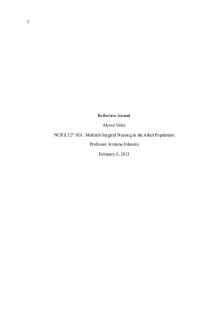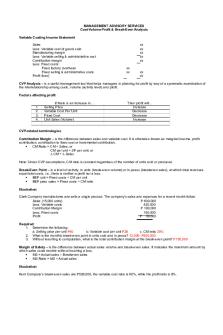CVP for Hemodynamics Reflection - Grade: A+ PDF

| Title | CVP for Hemodynamics Reflection - Grade: A+ |
|---|---|
| Author | CLARISSE GEMROSE CUÑADA |
| Course | Nursing |
| Institution | Centro Escolar University |
| Pages | 2 |
| File Size | 90.8 KB |
| File Type | |
| Total Downloads | 56 |
| Total Views | 158 |
Summary
THE USE OF CENTRAL VENOUS PRESSURE FOR THE ASSESSMENT OF PATIENTS'
HEMODYNAMICS (European Journal of Pharmaceutical and Medical Research, July 2019)...
Description
Cunada, Clarisse Gemrose D. BSN3C1 THE USE OF CENTRAL VENOUS PRESSURE FOR THE ASSESSMENT OF PATIENTS' HEMODYNAMICS
(European Journal of Pharmaceutical and Medical Research, July 2019) Summary: There is very little information available about how nurses use and estimate central venous pressure (CVP) readings to determine the hemodynamic status of their patients. CVP is one of the most frequently estimated hemodynamic parameters in critically ill intensive care unit (ICU) patients. The research study aims to investigate the extent to which nurses use CVP to assess intensive care unit (ICU) patients’ hemodynamics, through a new-developed Score and the parameters that affect this CVP usage. The research used a cross-sectional study of 120 critical care nurses. A structured 8-item questionnaire (CVP Score) was used to collect data on how nurses use CVP as an indicative parameter for patients' hemodynamics. After gathering the data and made a statistical computation, the Cronbach alpha was 0.89. The mean [±Standard Deviation (SD)] CVP Score was 15.8 (±5.7). Males (70.6% vs 37.2%, p=0.02) had significantly higher CVP Scores compared with females. In conclusion, CVP Score is a trustworthy questionnaire for being a tool used in diagnosing a patient. Nurses hypo-use CVP as a tool for assessing ICU patients' hemodynamic status. Males, on the other hand, use CVP at a significantly higher rate. Reflection: As nurses, we have the responsibility to care for our patients the best that we can. Even those with simple needs up to those critically ill patients and caring must be done with compassion, comfort, and love. Patients with cardiac diseases and who are critically ill are required to having hemodynamic monitoring in the critical care unit or in the ICU. CVP gives data about the ampleness of a patient's flow, perfusion, and oxygenation of the tissues and organ system. Nurses can help monitor it and coordinate with the doctors to ensure that the patient has optimal tissue perfusion and oxygen delivery while maintaining adequate mean arterial blood pressure. Being able to read an article about central venous pressure measurement specifically on how nurses use it, I have realized how much responsibility we have for the patient even in just a simple procedure that we can do and help. CVP measurement and monitoring were studied to help in diagnosing a critically ill patient to know the management nurses and physicians can do. Determining the CVP that the patient is experiencing can be a way of knowing his/her hemodynamic status. Nurses have the responsibility to measure it and that made me realize to always be careful in using the manometer and other equipment and accurate in everything I do
Cunada, Clarisse Gemrose D. BSN3C1
and in everything I measure because a simple mistake can endanger the life of the patient if not given the immediate and proper action/intervention he/she needs. I learned the use of stopcock in using a manometer, IV fluid with the CVP catheter, and how important it is to always document accurately. Furthermore, one thing that caught my attention is the result of the study that nurses, especially female nurses hypo-use CVP as a tool for measuring the hemodynamics of the patient. I think that in every hospital or place, there are different situations and I think if I will be given a chance to look after a patient that needs monitoring of CVP, I will still do my best to be careful and accurate because my goal is to help the doctors have the most accurate diagnosis and the best intervention for my patient. Still, CVP monitoring has proven to help a lot of patients and that it is really a reliable tool for diagnosing patients and assessing their hemodynamics. After all, whether we are male or female nurses, if CVP measurement is available and needed, we will do it no matter what for the sake of our patients. As a student nurse, one of my dreams is to become an operating room nurse aside from being a nurse anesthetist. With that, I am very inspired with what I have learned even with this minor surgery because I realized that even with just a simple procedure, we can save a life and we can help the patient feel better because of the interventions that can be given if diagnosed accurately. CVP measurement may be a simple procedure for nurses but I think it still can impart a major way to help the patient obtain optimal hemodynamics. Seeing how patients fight for their lives, and how doctors and nurses help each other to save lives is definitely something that I want to help with. Growing and learning lots of things, I learned to love the operating room not just because of the medical dramas that I watch but also because of the beauty of saving a life with surgery.
Reference: Brokalaki, H., Chatziefstratiou, A., Dokoutsidou, E., Fotos, N., Giakoumidakis, K. (July, 2019). The Use of Central Venous Pressure for the Assessment of Patients’ Hemodynamics. European Journal of Pharmaceutical and Medical Research. Retrieved from https://www.researchgate.net/publication/334232177_THE_USE_OF_CENTR AL_VENOUS_PRESSURE_FOR_THE_ASSESSMENT_OF_PATIENTS'_HE MODYNAMICS...
Similar Free PDFs

Reflection Essay - Grade: A
- 2 Pages

Final Reflection - Grade: a
- 3 Pages

Reflection 2 - Grade: A+
- 2 Pages

Reflection nutrition - Grade: A
- 3 Pages

Reflection - Grade: A
- 5 Pages

Reflection essay - Grade: A
- 3 Pages

Reflection Journal - Grade: A+
- 2 Pages

Self Reflection Paper - Grade: A
- 7 Pages

Reflection 5 audit - Grade: A
- 2 Pages

MKT Reflection Paper - Grade: A
- 1 Pages

Reflection Paper #3 - Grade: A
- 8 Pages

Additional Practices for CVP
- 11 Pages

CVP Analysis - CVP
- 9 Pages

Reflection #2 - Grade: B
- 3 Pages
Popular Institutions
- Tinajero National High School - Annex
- Politeknik Caltex Riau
- Yokohama City University
- SGT University
- University of Al-Qadisiyah
- Divine Word College of Vigan
- Techniek College Rotterdam
- Universidade de Santiago
- Universiti Teknologi MARA Cawangan Johor Kampus Pasir Gudang
- Poltekkes Kemenkes Yogyakarta
- Baguio City National High School
- Colegio san marcos
- preparatoria uno
- Centro de Bachillerato Tecnológico Industrial y de Servicios No. 107
- Dalian Maritime University
- Quang Trung Secondary School
- Colegio Tecnológico en Informática
- Corporación Regional de Educación Superior
- Grupo CEDVA
- Dar Al Uloom University
- Centro de Estudios Preuniversitarios de la Universidad Nacional de Ingeniería
- 上智大学
- Aakash International School, Nuna Majara
- San Felipe Neri Catholic School
- Kang Chiao International School - New Taipei City
- Misamis Occidental National High School
- Institución Educativa Escuela Normal Juan Ladrilleros
- Kolehiyo ng Pantukan
- Batanes State College
- Instituto Continental
- Sekolah Menengah Kejuruan Kesehatan Kaltara (Tarakan)
- Colegio de La Inmaculada Concepcion - Cebu

